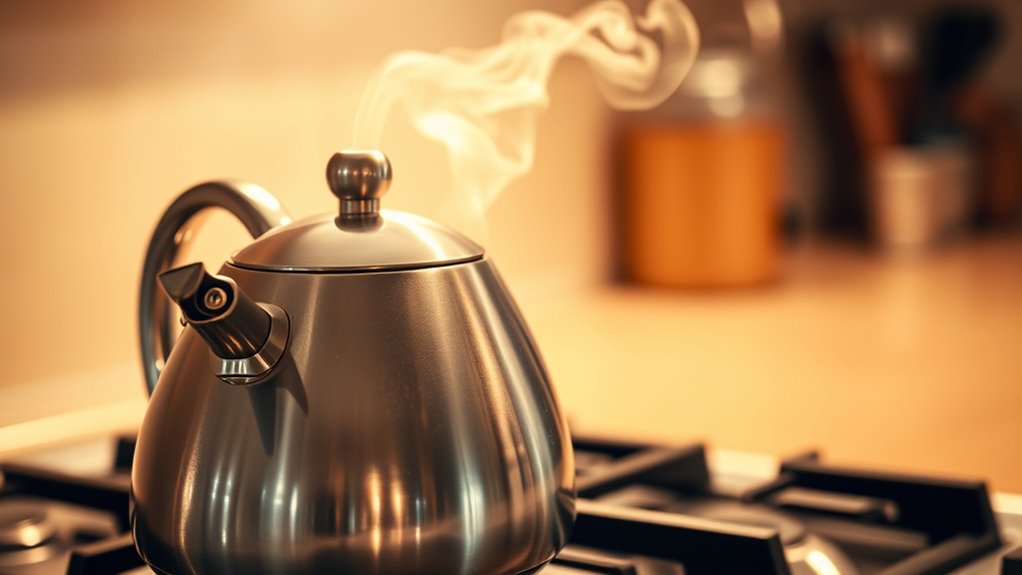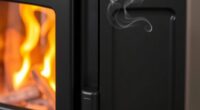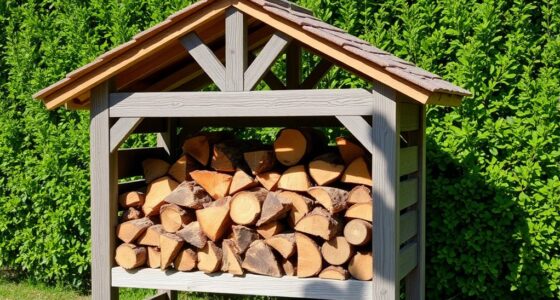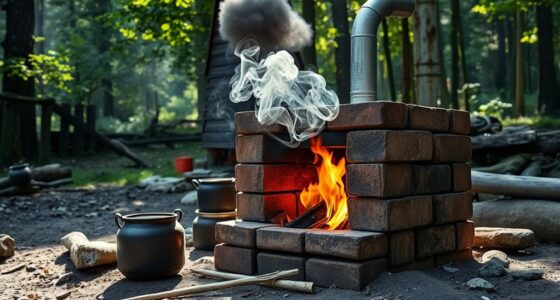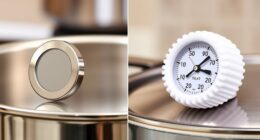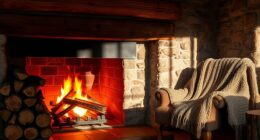To turn your stovetop into a humidifier, fill a kettle with water and place it on the burner. Heat it until the water boils or simmers gently, releasing steam into the air. Position the kettle where steam can disperse freely, like near the center of the room. Adjust the heat to control humidity levels, and remember to refill and clean it regularly for best results. Keep exploring to learn more tips on optimizing your homemade humidifier.
Key Takeaways
- Use a clean, dry kettle filled with distilled or filtered water to prevent mineral buildup.
- Place the kettle centrally on the stove and turn on low to moderate heat to produce gentle steam.
- Position the spout to direct steam toward the ceiling for even humidity distribution.
- Keep the area around the kettle clear to allow proper steam circulation and prevent accidents.
- Regularly refill, clean, and descale the kettle to maintain optimal humidifying performance.
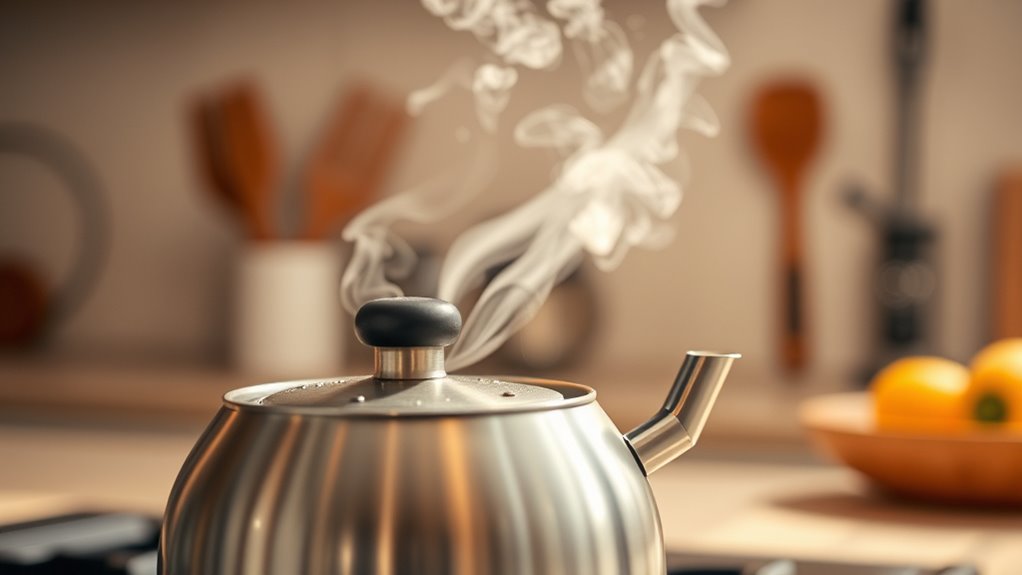
A stove-top water kettle can double as a simple humidifier to add moisture to dry indoor air. When you heat water in the kettle, the evaporation process begins, transforming liquid water into steam. This steam then disperses into the surrounding air, increasing humidity levels naturally. Unlike commercial humidifiers, a kettle offers a straightforward, cost-effective way to improve indoor comfort without complicated settings or maintenance.
As the water heats, the evaporation process takes center stage. The heat causes molecules at the water’s surface to gain energy and escape into the air as vapor. The more vigorous the boil, the more steam is produced, effectively adding moisture to the room. You can control the humidity level by adjusting the heat—keeping it simmering gently for a steady, gentle release or turning it up for more rapid moisture production. Just be cautious not to let the water run dry, as this can damage your kettle or cause safety hazards.
Steam distribution is another key aspect of turning your kettle into a humidifier. When steam rises from the spout, it naturally disperses into the room. To optimize this distribution, position the kettle near a central location or in an area where the steam can circulate freely. Avoid blocking the steam’s path with objects or placing the kettle in a corner. The steam will spread across the space, raising the humidity evenly, especially if you keep doors or windows open slightly to facilitate airflow. You might notice that the steam tends to rise, so pointing the spout toward the ceiling can help distribute moisture more effectively throughout the room. Additionally, using a humidifier app or device can help monitor and maintain optimal humidity levels for comfort and health.
One advantage of using a kettle as a humidifier is that it doesn’t require electricity beyond the heat source, making it energy-efficient and simple to operate. Plus, you can add herbs, essential oils, or even a splash of tea to the water for a pleasant aroma while humidifying. Incorporating water quality considerations can help prevent mineral buildup and ensure cleaner steam. Regularly cleaning the kettle and using distilled or filtered water can further improve steam quality and reduce mineral deposits. Using appropriate cleaning tools and techniques can help maintain the kettle’s longevity and performance. Just remember to regularly refill the kettle and clean it to prevent mineral buildup, which can hinder the evaporation process and affect steam quality.
In essence, your stove-top water kettle harnesses basic physical principles—evaporation and steam distribution—to improve indoor air quality. By controlling the heat and positioning the kettle thoughtfully, you can maintain a comfortable humidity level, making your space more inviting and healthier. This simple method offers a natural, effective way to combat dry air, especially during winter months or in arid climates.
Frequently Asked Questions
Can I Use Any Type of Water in the Kettle Humidifier?
You shouldn’t use any type of water in your kettle humidifier. It’s best to use distilled or filtered water because water quality varies and tap water often contains minerals. Using mineral-rich water can lead to mineral buildup inside the kettle, reducing efficiency and causing damage over time. Opt for purified water to keep your humidifier clean, working smoothly, and free of mineral deposits.
How Often Should I Clean the Kettle to Prevent Mold?
Did you know mold spores can grow within 24-48 hours if you neglect cleaning? You should clean your kettle at least once a week to prevent mold. Regular kettle cleaning eliminates mineral buildup and mold, keeping your humidifier safe and effective. Be sure to empty, rinse, and scrub the kettle thoroughly, especially around the spout and lid. Consistent maintenance guarantees healthy, clean humidity for your space.
Is It Safe to Leave the Kettle on Unattended?
It’s not safe to leave your kettle on unattended because it can overheat or boil dry, creating a fire hazard. Always follow safety precautions and appliance maintenance guidelines, like turning it off once the water boils and never leaving it unattended for long periods. Regularly check for mineral buildup or damage, and verify the kettle is clean and in good condition before use. Your safety depends on your careful handling.
Will the Steam Damage My Stove or Countertop?
Steam from your kettle won’t damage your stove or countertop if you keep an eye on it. Proper stove safety involves ensuring the kettle is stable and not overheating. While steam can affect certain surfaces over time, using a trivet or placing a heat-resistant mat can prevent countertop damage. Regularly monitoring the kettle and keeping the area dry helps maintain safety and prevents any potential harm to your stove or countertop.
Can I Add Essential Oils to the Water in the Kettle?
You can add essential oils to your kettle’s water, but you should do so with caution. Essential oil safety is key; avoid using too much or oils that could damage the kettle or pose health risks. For aromatherapy benefits, add a few drops, but never directly into the heating element. Keep the area well-ventilated, and only use high-quality, safe oils to enjoy soothing aromas without harm.
Conclusion
Now, every time you boil water on your stove, you’re not just making tea—you’re adding life to your room. Think of your kettle as a tiny cloud-maker, releasing moisture like a gust of fresh air on a crisp morning. Just like a warm hug, this simple trick can turn dry, stuffy spaces into cozy retreats. So, embrace your kettle’s new role—your personal weather station that keeps your home comfortably humid all year round.

